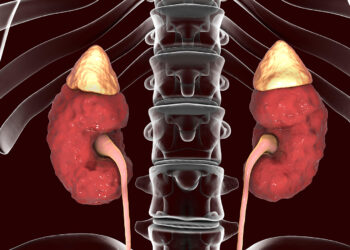HELSINKI, Finland — An artificial intelligence (AI)–based clinical decision support system helped doctors make decisions in the treatment of acute ischemic stroke and was associated with a significant reduction in recurrent vascular events in a new, randomized trial.
The AI system integrated clinician input with data from the hospital records and imaging of more than 20,000 patients in China to help guide patient management around stroke etiology and secondary prevention.
The trial represents a strong case for the future role of AI in stroke care, said Study Chair, Li Zhang, MD, Beijing Tiantan Hospital, Capital Medical University, Beijing, China. “By harnessing AI to deliver rapid, evidence-based guidance, we’ve shown that decision support can move beyond theory into practice — improving both how we treat acute strokes and the lives of our patients.”
However, experts not involved in the study noted that the research is based on Chinese stroke guidelines — which differ from guidelines in the United States and United Kingdom — and would need to be replicated in the West before use.
Zhang presented the results of the GOLDEN BRIDGE II trial on May 22 at the European Stroke Organization Conference (ESOC) 2025.
A Test of AI in Stroke Management
Rapid and accurate decision-making is critical in acute stroke management, and AI tools offering automated imaging analysis, stroke subtype classification, and guideline-based treatment recommendations, hold promise for standardizing care and improving outcomes, Zhang noted.
The GOLDEN BRIDGE II trial was designed to test this hypothesis in a real-world, multicenter setting. The trial, which had a cluster randomized design, was conducted from January 2021 to June 2023 in 77 hospitals in China. The hospitals were randomized to use the AI support system or to continue usual care.
The AI system provided automated MRI lesion detection and lesion characteristics analysis, algorithmic classification of stroke etiology and pathogenesis, with real-time, guideline-based recommendations for secondary prevention.
The trial included 21,603 patients with acute ischemic stroke (median age, 67 years; 35% women), with 96% completing a 12-month follow-up.
The primary endpoint was the occurrence of new vascular events (composite of ischemic stroke, hemorrhagic stroke, myocardial infarction, or vascular death) at 3 months after stroke onset.
A ‘Strong Case’
Results showed that patients for whom the AI model was used had significantly fewer recurrent vascular events at all three time points evaluated.
Rates of recurrent vascular events in the intervention group vs the control group were 2.9% vs 3.9% (adjusted hazard ratio [aHR], 0.71; P < .001) at 3 months; 3.4% vs 4.8% (aHR, 0.70; P < .001) at 6 months; and 4.0% vs 5.5% (aHR, 0.70; P < .001) at 12 months.
The use of the AI tool was also associated with a lower all-cause mortality at 6 months (2.0% vs 2.3%; aHR, 0.78; P = .007) and at 12 months (3.0% vs 3.5%; aHR 0.77; P < .001).
In addition, patients at the hospitals using the AI tool were more likely to achieve a higher composite acute ischemic stroke quality score (91.4 % vs 89.7 %; odds ratio, 1.26; P < .001).
A potential limitation of the study was the cluster randomized design, which could allow variations in care between hospitals to influence the results.
But Zhang concluded that the trial represents a strong case for the future role of AI in stroke care, saying that the findings “support wider adoption of AI-driven decision support to optimize acute stroke care and patient outcomes globally.”
Not Ready for Routine Clinical Use
Commenting on the findings during a discussion on the GOLDEN BRIDGE II trial, Carlos Molina, MD, head of Neurology at Vall d’Hebron Hospital, Barcelona, Spain, noted several study strengths, including the large study cohort and the clinical and technological validation of the sophisticated AI system used in the trial.
“This is an important step,” he added, “but there are always concerns when we think about trying to integrate AI into clinical practice.”
Georgios Tsivgoulis, MD, professor of neurology at the National and Kapodistrian University of Athens, Athens, Greece, noted that although there was a substantial reduction in vascular events and recurrent strokes in the intervention group, the mechanisms that led to this reduction were not clear.
“How did the AI improve clinical practice? Was it through imaging, was it because of better adherence to the Chinese stroke guidelines or was it related to better stroke subtype classification and perhaps treatment individualization? I would like to see more information about the step between the AI implementation and the event reduction results,” he commented.
Karin Klijn, professor and chair of neurology at Radboud University Medical Center, Nijmegen, the Netherlands, said the improvement in recurrent events appeared to be driven by the imaging. “But we didn’t hear any details, and we need to see more details so we can see where improvements can be made.”
“However, this was an impressive study in that it involved more than 70 hospitals and more than 20,000 patients. I think AI will help us to achieve the same level of confidence for all the images we have to examine and decisions we have made. I see great potential for this technology,” Klijn added.
The trial would also need to be replicated in the Western world for the AI tool to be used in Europe or North America, Tsivgoulis said.
“The GOLDEN BRIDGE II trial is based on the Chinese stroke guidelines which are substantially different from European and US stroke guidelines,” he pointed out. “It would need to be replicated in Europe and North America using standardized European Stroke Organization and American Stroke Association guidelines to see if this huge beneficial effect can be replicated in Western patients.”
Molina agreed, adding that “the data sources used to train this model are critical to avoid bias that AI can amplify.”
In the future, more complex large language models will be available that involve real time interaction with the user and include reinforcing learning, Molina added.
“This prototype is evolving and interaction with the user is critical. There is a lot to learn about that. But this is the first step,” he said.
Also commenting, Alastair Webb, MD, clinical reader in stroke medicine at Imperial College London, London, England, also had questions on how it could be implemented in practice.
“This study was designed a few years ago and has taken years to produce these results. How do we keep the algorithm updated and incorporate the continuous changes in clinical practice that occur? We can’t do a trial for every update. So we are going to have to integrate this technology into our systems with some sort of real time method of assessing whether every new evolution doesn’t cause harm, doesn’t make the wrong decision in a large language model.”
Source link : https://www.medscape.com/viewarticle/ai-tool-linked-fewer-recurrent-events-after-stroke-2025a1000enr?src=rss
Author :
Publish date : 2025-05-30 10:04:00
Copyright for syndicated content belongs to the linked Source.












